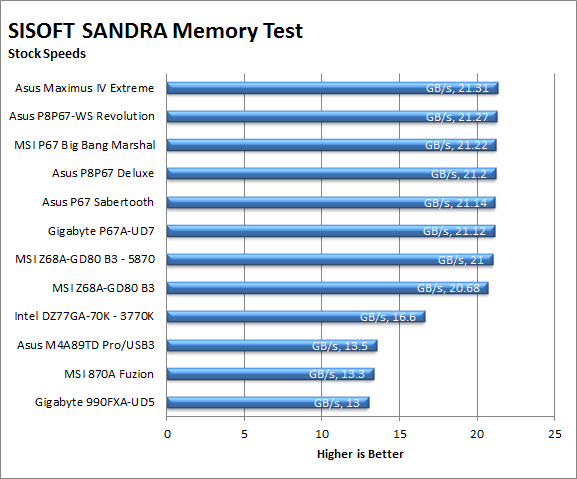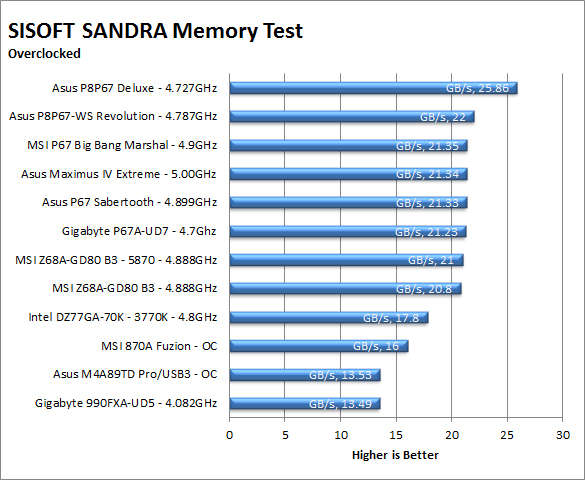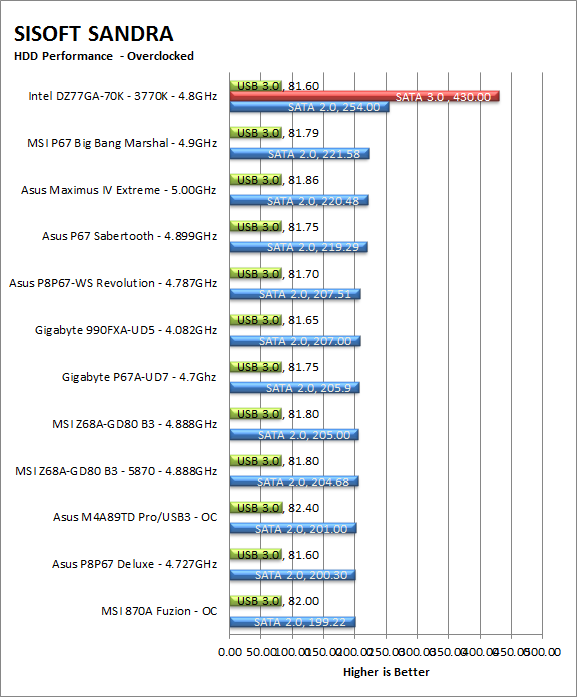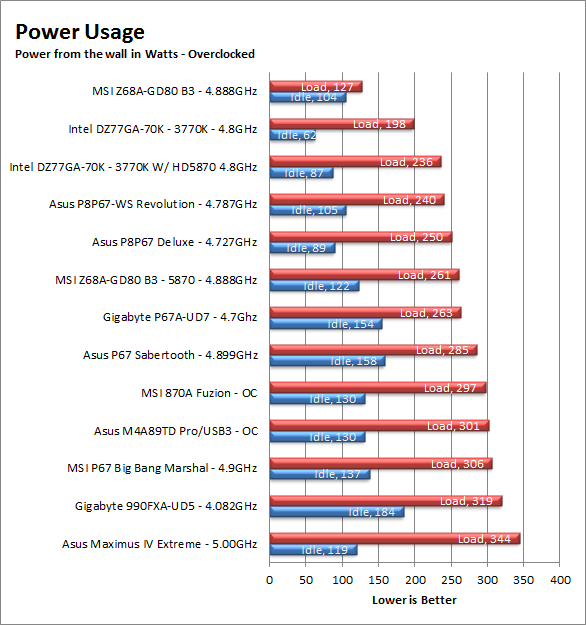Section 1 Subsystems
Memory -
Memory performance is very important on a motherboard, especially when you have a CPU with multiple cores and threads. If you have slow memory your cores and threads can become starved for data to execute. To test memory performance we run both Sisoft’s SANDRA and AIDA64. These two combine to not only give us accurate numbers but to validate each other. For testing at stock speeds the memory is hard set to 1333MHz while overclocking testing is done at the highest stable speed for the voltage of 1.65v this is due to the different memory dividers for each CPU. As such, the memory speeds will vary greatly. This means that the overclocked numbers are a little misleading and while they can show a trend are really only included to show if a board has a problem with memory performance at high clockspeeds.

Again as we told you with our coverage of the Core i7 3770K the memory bandwidth is not what we have come to expect. Instead of being in the 20-22GB/s range we find ourselves back in the 16-17GB/s range. Normally this would be a serious concern, but we do know that the new instructions in Ivy Bridge compensate for this quite nicely. Now we just need to make sure that the rest of the board can deal with this as well.

Drive performance -
Drive performance is also one of the major subsystems that goes to make up the performance of a motherboard. For our testing we use Sandra and AIDA64 again. We only test with single drives for each type of controller present on the motherboard (unless it is a professional product where we will use RIAD 5 and/or 10). We have also begun using a Seagate PS-110 USB 3 external HDD and a Kingston HyperX USB 3.0 Flash drive for our USB 3.0 performance. As a side note, we include the overclocked numbers here to make sure (again) that you are not going to see a major drop in performance due to minor instabilities at high clock speeds.

The SATA performance on the DZ77GA-70K is outstanding. Even the SATA 3.0 performance is up there although we did have to clear out the numbers for the other products since we moved to using the Kingston SATA 3 SSDs). Additionally, our testing of the USB 3.0 ports from the PCH yielded good performance with both our USB 3.0 HDD and the Kingston HyperX USB 3.0 Flash drive. Here we saw a 253 MB/s rating under Sandra

Power -
Power efficiency is another of those misnomers that we get caught up in. We hear about idle states and power gates. But what does that mean to you and I? On the surface having power management that reduces idle power sounds great and can be a benefit to someone that leaves their system on for long periods of time (and inactive) but how a system handles power under load and the delta between the two states is often more important than the idle power usage numbers. We use only P3 Kill A Watt instruments for measuring power.

For power draw the Intel DZ77GA-70K was very efficient even when we had our EAH 5870 V2 from Asus running. This is good news for people looking to maintain energy efficiency and good performance.

Cooling (Board Level) -
Board level cooling is an important factor in product performance and longevity. Components like the chipset, VRM modules and even capacitors need to be kept relatively cool to prevent failure. As these parts are made of silicon, they have a thermal breakdown threshold; or melting point. At that temperature the actual transistors built into chip will begin to deform and break down. Granted, the threshold is often very high, but you still need to make sure that components stay away from this level of heat for longer product life.

As we mentioned in our walk around of the board we had concerns that the Z77 PCH would get a little hot with the small heatsink. We were right to worry about this as we see it runner much hot than any other boards we have tested to-date. - Update- It appears there was an issue with our Fluke 62 Mini. The internal switch that changes the reading from Farenheit to celcius was not working as it should. we have made the calculations to adjust the temps and you can see the results below. We apologize for this as the reading still showed c in the display. However it is obvious that it was not reading properly when we used a second IR thermometer for verification after user comments

Audio -
Audio is highly subjective. What we find pleasing may sound “off” to you. That is always going to the problem with testing audio; results will vary too widely depending on the tastes of the listener. However, there are ways of measuring the audio output with an objective ear. There is also the issue of audio causing performance issues in gaming and video playback. The reason this is a potential source of concern is that all onboard audio CODECs (Compression/Decompression) are CPU controlled. This means that while the audio chip controls the audio levels and effects of the audio the actual work is done on the CPU. Usually this will not be a problem with today’s powerful CPUs. Even the lower and consumer level products can handle high-end audio these days. But again there is the chance that a bad design or software will hinder your system and performance. On the other side the limits of board space, cost, etc will also prevent the level of audio quality you can get from an add-in board. We test all audio parts with three media types, Movie (DVD), MP3 Music, and Gaming. These are pushed to our Tec On model 55 Tube Amp to see if we can detect any signal issues in the reproduction.
The audio on the DZ77GA-70K is pretty good. It will do for most things that you want to listen to, but is not going to win any awards or leave you in awe of its quality. If you need sound, this will fit the bill.
Networking -
This one is something that is a requirement anymore. If you have a computer, the chances are good (like 99%) that you are also connected to high-speed internet. With this you need a good and solid LAN chip to make sure that your data flows properly out and back.
The networking performance was another matter completely. Here we have two Intel LAN controllers which can be used independently or teamed for more available bandwidth. On the wireless side you have an external Ralink (RT8070) USB wireless device that allows you to connect to 802.11b, g, and n with a maximum possible speed of 150Mb/s. This is most likely due to it being a single antenna product which will limit the possible speeds it can run at. We found that our average connection was around 100Mb/s using the wireless devices we have in the lab.

 Although the Intel Z77 Express chipset has been available for a while now we chose to wait until the official launch of Ivy Bridge to begin our reviews. After all the Z77 with Panther Point was designed to get the best performance when tied with Ivy Bridge so why not show that off first. To kick off our coverage of the Z77 we deiced to try out Intel’s reference design in the DZ77GA-70K. This performance desktop board from Intel is a great starting point and will give us the feel of how Intel meant things to work. So let’s get to it shall we?
Although the Intel Z77 Express chipset has been available for a while now we chose to wait until the official launch of Ivy Bridge to begin our reviews. After all the Z77 with Panther Point was designed to get the best performance when tied with Ivy Bridge so why not show that off first. To kick off our coverage of the Z77 we deiced to try out Intel’s reference design in the DZ77GA-70K. This performance desktop board from Intel is a great starting point and will give us the feel of how Intel meant things to work. So let’s get to it shall we?

